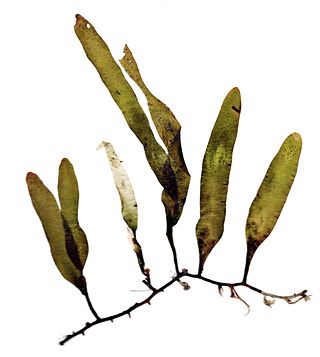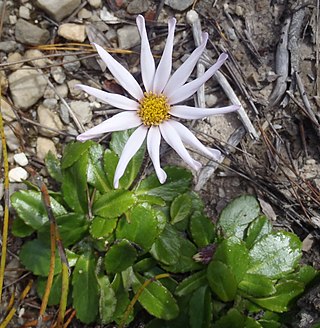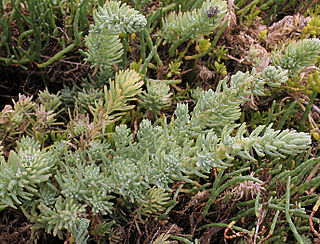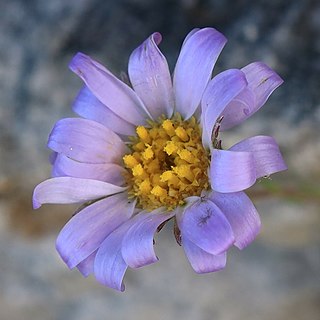
Prumnopitys taxifolia, the mataī or black pine, is an endemic New Zealand coniferous tree that grows on the North Island and South Island. It also occurs on Stewart Island/Rakiura but is uncommon there.

Caulerpa taxifolia is a species of green seaweed, an alga of the genus Caulerpa, native to tropical waters of the Pacific Ocean, Indian Ocean, and Caribbean Sea. The species name taxifolia arises from the resemblance of its leaf-like fronds to those of the yew (Taxus).

Torreya State Park is a 13,735 acre (56 km²) Florida State Park, United States National Natural Landmark and historic site thirteen miles (19 km) north of Bristol. It is located north of S.R 12 on the Apalachicola River, in northwestern Florida, at 2576 N.W. Torreya Park Road.

Caulerpa is a genus of seaweeds in the family Caulerpaceae. They are unusual because they consist of only one cell with many nuclei, making them among the biggest single cells in the world.

Caulerpa racemosa is a species of edible green alga, a seaweed in the family Caulerpaceae. It is commonly known as sea grapes and is found in many areas of shallow sea around the world. Despite the name, it is not related to grapes. There are a number of different forms and varieties, and one that appeared in the Mediterranean Sea in 1990, which is giving cause for concern as an invasive species.

Torreya taxifolia, commonly known as Florida torreya or stinking-cedar, but also sometimes as Florida nutmeg or gopher wood, is an endangered subcanopy tree of the yew family, Taxaceae. It is native to only a small glacial refugium in the southeastern United States, at the state border region of northern Florida and southwestern Georgia.

Elysia subornata is a species of small sea slug, a marine opisthobranch gastropod mollusk in the family Plakobranchidae.
Juniperus taxifolia is a species of juniper, endemic to the Bonin Islands southeast of Japan.

Bryopsidales is an order of green algae, in the class Ulvophyceae.

Juniperus lutchuensis or Ryūkyū juniper is a species of juniper native to the Ryūkyū Islands, Izu Islands, Izu Peninsula, and Bōsō Peninsula, Japan.

Darwinia taxifolia is a species of flowering plant in the myrtle family Myrtaceae and is endemic to New South Wales. It is an erect or low-lying shrub with laterally compressed leaves. The flowers are pink or purplish and usually arranged in groups of two to four.

Mairia is a genus of perennial herbaceous plants assigned to the family Asteraceae. All species have leathery, entire or toothed leaves in rosettes, directly from the underground rootstock, and one or few flower heads sit at the top of the stems that carry few bracts. These have a whorl of white to mauve ray florets surrounding yellow disc florets in the centre. In general, flowering only occurs after the vegetation has burned down. The six species currently assigned to Mairia are endemic to the Western Cape and Eastern Cape provinces of South Africa. Some of the species are called fire daisy in English and vuuraster in Afrikaans.

Salix taxifolia, the yewleaf or yew-leaf willow, is a species of willow native to all of southern Mexico, also Pacific Coast regions, north to Sinaloa, and in the south Pacific Coast of Mexico into central Guatemala. Scattered populations are also reported from northern Mexico and from the US states of Texas, New Mexico, and Arizona.

Salix bonplandiana, , is a perennial species of willow tree native to southern and southwest Mexico and extending into central Guatemala; in western Mexico it is a tree of the Sierra Madre Occidental cordillera, but also occurring in other small locales, for example Baja California Sur, northern Sonora, San Luis Potosi, etc. A core disjunct area occurs in central and southeast Arizona, in advantageous locales, especially associated with higher elevations and water.

Suaeda taxifolia is a species of flowering plant in the family Amaranthaceae known by the common name woolly seablite.

Zyrphelis is a genus of African flowering plants in the tribe Astereae within the family Asteraceae.
Rusbya is a monotypic genus of flowering plants belonging to the family Ericaceae. It only contains one known species, Rusbya taxifoliaBritton

The Torreya Guardians is a self-organized group of conservationists dedicated to facilitating the assisted migration of the Florida torreya by rewilding it further north than its native range in Florida and Georgia. Founded in the early 2000s, the group is often mentioned as an instigator of the assisted migration of forests in North America for conservation and climate adaptation purposes. It is an example of citizen-initiated citizen science.
Mirbelia taxifolia is a species of flowering plant in the family Fabaceae and is endemic to inland Western Australia. It is a shrub that typically grows to a height of 60–90 cm (24–35 in) and has orange-yellow flowers in September. It grows in sandy soil in the Coolgardie bioregion of inland Western Australia.
















